Understanding how to read your bill and which elements are the most important ones can help us figure out whether we're on the right tariff.
Checking all the details are accurate can also prevent problems popping up, including overpaying, underpaying or being moved to an expensive tariff.
Energy companies are required to provide bills with clear and detailed information, and we show how this works in practice with an example bill below.
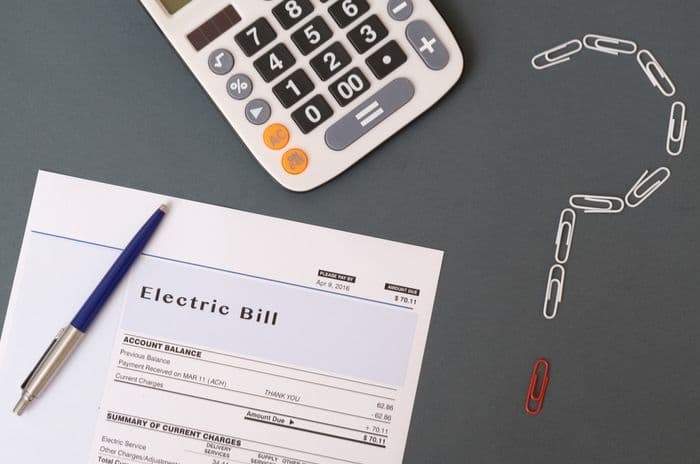
Why bother decoding your energy bill?
Understanding our energy bill is the first step towards working out whether we're paying too much for energy and whether we could save money by switching to a new supplier.
Decoding the key information on our energy bills and regularly checking them can:
- Help us understand how much energy we're using
- Prevent us overpaying for our energy supply
- Ensure we're being billed correctly
- Help us keep track of our tariff
While it's easy to assume that everything is fine with our energy bills (especially when we receive them by email or have to log in to an online account to download them), checking and understanding them can prevent any surprises and help us work out how we can lower our energy usage.
Learn more about common problems with energy bills.
What should you be looking for on your energy bill?
There are a few key things to watch out for on your energy bill, including:
- Meter readings: Your most recent gas and electricity meter readings should be displayed on your bill. These could be readings you've provided (indicated with a 'C' for customer), one's they've taken (indicated by an 'A' for actual) or estimated readings (indicated by an 'E'). If your bill has been estimated, you should call your supplier with up to date readings (or submit them online) to ensure you're being billed accurately.
- Tariff: The name of your tariff is helpful if you're looking to switch supplier, as it will allow you to compare offers accurately.
- TCR: The 'tariff comparison rate' or TCR, shows you how much you pay per kWh when all charges are included in the cost. Your tariff may have standing charges and other costs included, so this rate allows you to compare deals from different suppliers more easily. Be aware, it may not always be labelled as this and could just be a figure explaining how much you pay per kWh.
- Payment amount and date: Often printed on the first page is the amount you're going to pay when the next direct debit comes out. If you pay on receipt of bill, it's what you'll be paying.
- Energy use: If you don't yet have a smart meter installed, your energy use, which is printed on your bill, can be handy to know. If it's suddenly very different to what you'd usually use, it could be worth investigating in case there has been a billing error or an appliance has become faulty.
- MPAN or MPRN numbers: Your supply numbers are called Meter Point Administration Number (MPAN) for electricity and Meter Point Reference Number (MPRN) for gas. Your MPAN will start with an 'S' and have 21 digits, and your MPRN will be up to 10 digits long. Both of these numbers can be handy to keep a note of, as having them to hand can make switching supplier much quicker.
- Terms and conditions: Somewhere on your bill should be the terms of the contract you are on. If you are on a fixed plan, your supplier should let you know around 49 days from the end of your contract that it's coming to a close. Between then and the end of the term, you are free to seek a new contract with them, or another supplier. Understanding when the right time to switch is can keep you off expensive default tariffs.
There are some things which your bill won't explain to you, in particular what a kWh actually means. A kilowatt hour (kWh) is how your electricity use in measured. If you use an appliance that's rated at 1,000 watts (or 1kW) for one hour, that will cost you 1kWh. If the appliance is rated 500w, it will only cost you 0.5kWh.
Understanding energy consumption can feel confusing, but it's not crucial to get to grips with the maths behind the numbers. What's important for you to know is how much energy you've used (measured in kWh), whether that's a 'normal' use for you, and how much that's going to cost you.
In practice: looking at an energy bill
To better illustrate how an energy bill looks in practice, let's use an example from a member of the Choose team.
This bill is made up of five pages, although the last one simply contains details of how to contact the energy supplier and so isn't shown.
Let's take a look at the first page which shows an overview of the bill alongside all the important information about the property.
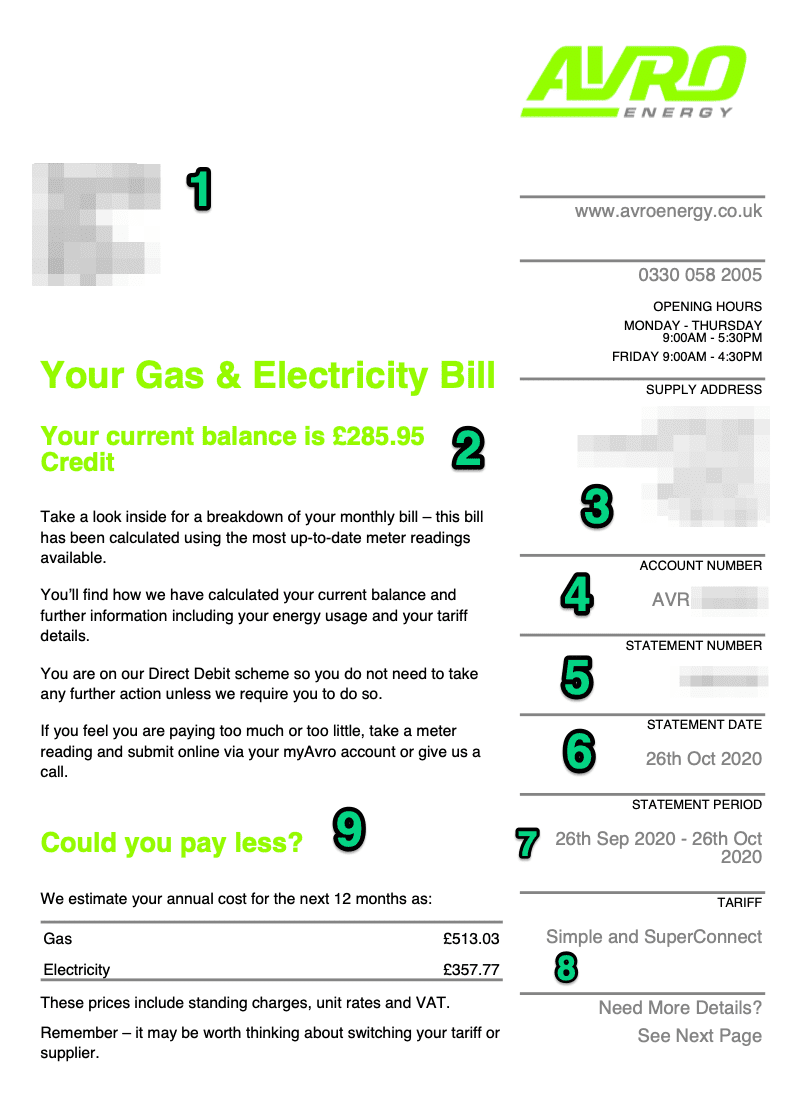
The first page of this recent bill from Avro Energy includes the following features:
- Address - This is the address the bill was sent to. Bear in mind, this might not be the home you currently live in if you've moved house recently and this is a final bill for a different property. Usually, though, this will be your current address.
- Current balance - The figure here shows the customer's current balance. On this statement, the customer is in credit, so this is a positive figure rather than an amount owed by the customer. If a customer pays their bill on receipt rather than through direct debit, this amount will usually be the amount owed immediately.
- Supply address - This the address the energy bill is for.
- Account number - This is the customer's account number with the energy provider. This should be quoted when dealing with an energy supplier.
- Statement number - This is the energy provider's record of the statement number - quoting this is useful if customers are trying to talk to customer service about a bill issue.
- Statement date - This is the date the statement was issued.
- Statement period - This is the date the bill covers. In this case, it's a monthly bill, but some customers pay their energy bills quarterly and this section will reflect that.
- Tariff - This is the name of the tariff the customer is on.
- Annual estimates - This is the estimate of the total gas and electricity costs over the next 12 months, split down by fuel. It comes with a note that customers could save by switching to another tariff or another supplier.
So, this overview page allows us to see some basic information about our bill, but it's worth checking on the following:
- Is the supply address accurate?
- Is the tariff what you were expecting it to be?
- Does the credit balance or amount owed at the top of the bill look correct?
There's more detailed information on page two of this energy bill from Avro:
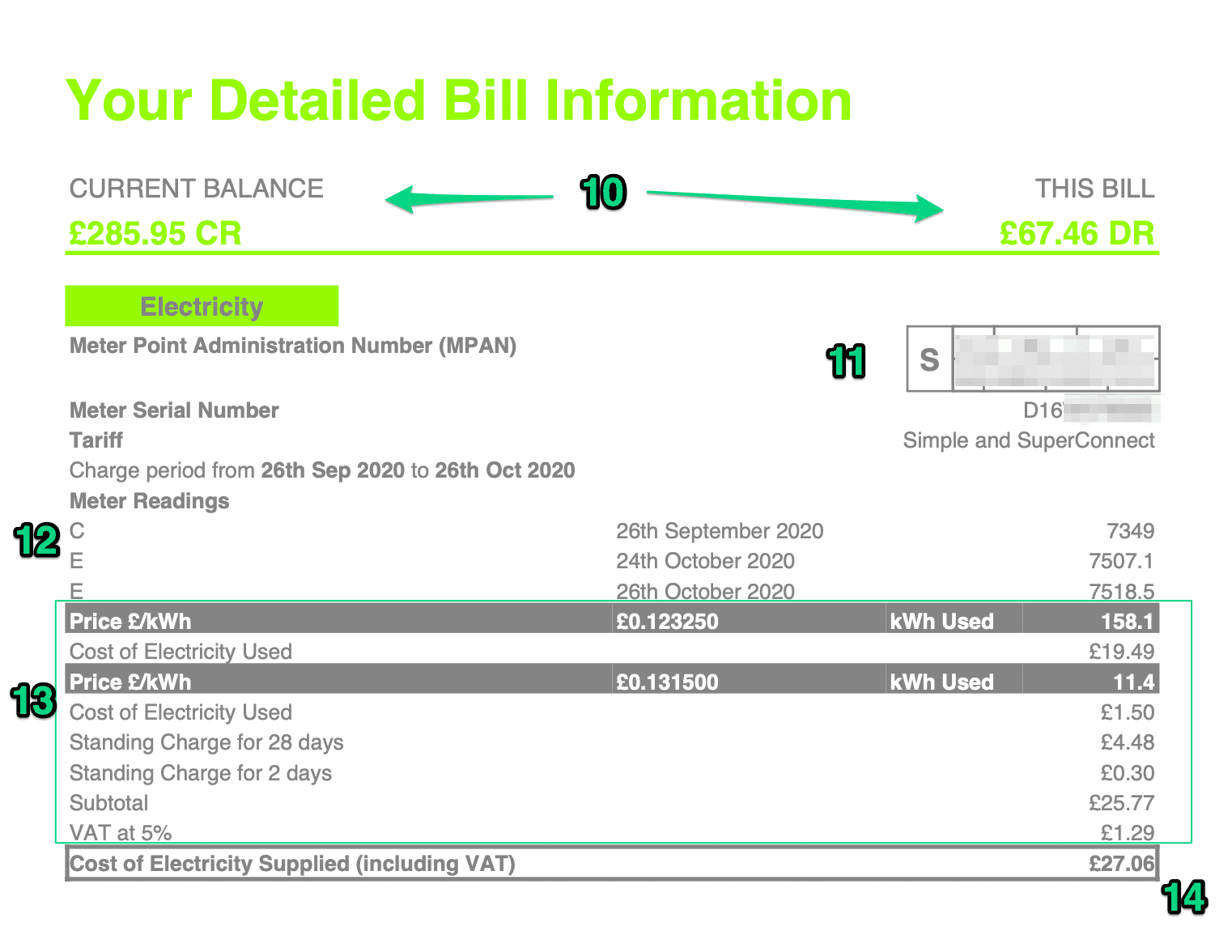
On this second page, we get more details of the electricity element of the bill:
- Current balance - These figures demonstrate the account is in credit of £285.95 (on the left) and that the customer has used £67.46 of energy over the statement period this bill relates to.
- Meter information - This part of the bill looks slightly confusing until we realise the information on the left relates to the numbers on the right. So, the Meter Point Administration Number (MPAN) is in the box while the Meter Serial Number is below it. Then, below that, is the name of the tariff again and confirmation once more of the charging period for this bill. In this case, it covers 26 September 2020 through to 26 October 2020.
- Meter readings - This section provides details of any meter readings supplied during the charge period. The "C" indicates the reading the customer supplied themselves while "E" references an estimate by the energy company. Although one isn't present on this bill, there could also be an "A" to denote a meter reading taken by a representative of the company.
- Cost of electricity details - This technical section covers the amount of electricity used during the statement period and how much the different elements cost. Note: this bill looks slightly more complicated because the "Cost of Electricity Used" and "Standing Charge" sections are split up. This is due to the estimated meter readings mentioned above - there were two of them so there are two electricity/standing charge elements.
- Cost of electricity supplied - This is the total amount charged for electricity during the period, including VAT which was added in the step above. So, this is the proportion of the charges at the top of the page (see 10) that relate to the amount of electricity the household used. In this case, £27.06 of the total £67.46 was electricity usage.
If this is the first time you've looked in detail at your energy bill or if you're checking to see if everything is accurate, ask the following questions:
- Are the MPAN and Meter Serial Number accurate?
- Is the tariff accurate?
- Do the meter readings listed correspond with those taken or are they wildly inaccurate?
- Is the amount of energy (i.e. the kWh used during the statement period) accurate or has it been miscalculated?
- Do the sums add up for the cost of electricity supplied?
Learn more about what electricity and gas costs and why understanding that can help you understand which energy supplier is best for your needs.
Now we've seen the electricity costs for the statement period, let's take a look at the gas costs on the third page of this dual fuel energy bill:
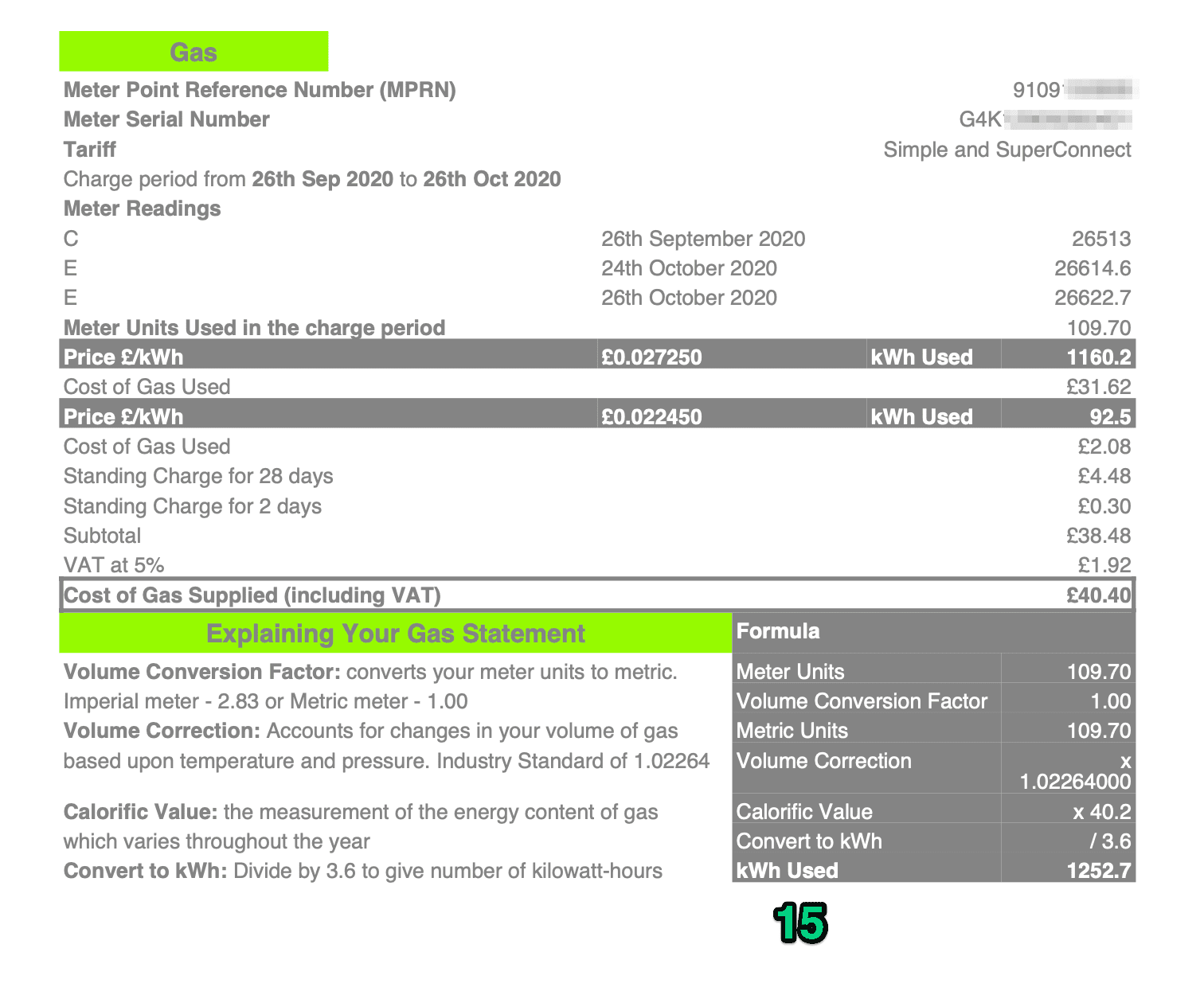
Much of the information on the third page will be familiar as it's similar to the details listed on page two of this bill. However, you can see the MPRN is in a different format and there is much more detailed information at the bottom of the page about how the gas portion of the bill is calculated.
Again, we have customer supplied and estimated meter readings to show how many kWh of gas were used during the statement period, and we have the same split costs/standing charges due to the dual estimated readings.
The new information, though, are the formula details:
- Explaining your gas statement - This section shows how the units on the customer's meter match with the number of kWh used. This can be a tricky element of the bill to understand, but it's important because it gives clarity over how the numbers we see on our meters correspond with the amount of gas an energy supplier say we have used - this means we can understand how much gas we're using within a statement period rather than relying on the meter units which mean little.
The questions to ask about accuracy are the same for the gas supply as they are for the electricity supply mentioned on page two.
Finally, page four of this energy bill from Avro Energy gives more details about the customer's balance, tariff and payment information:
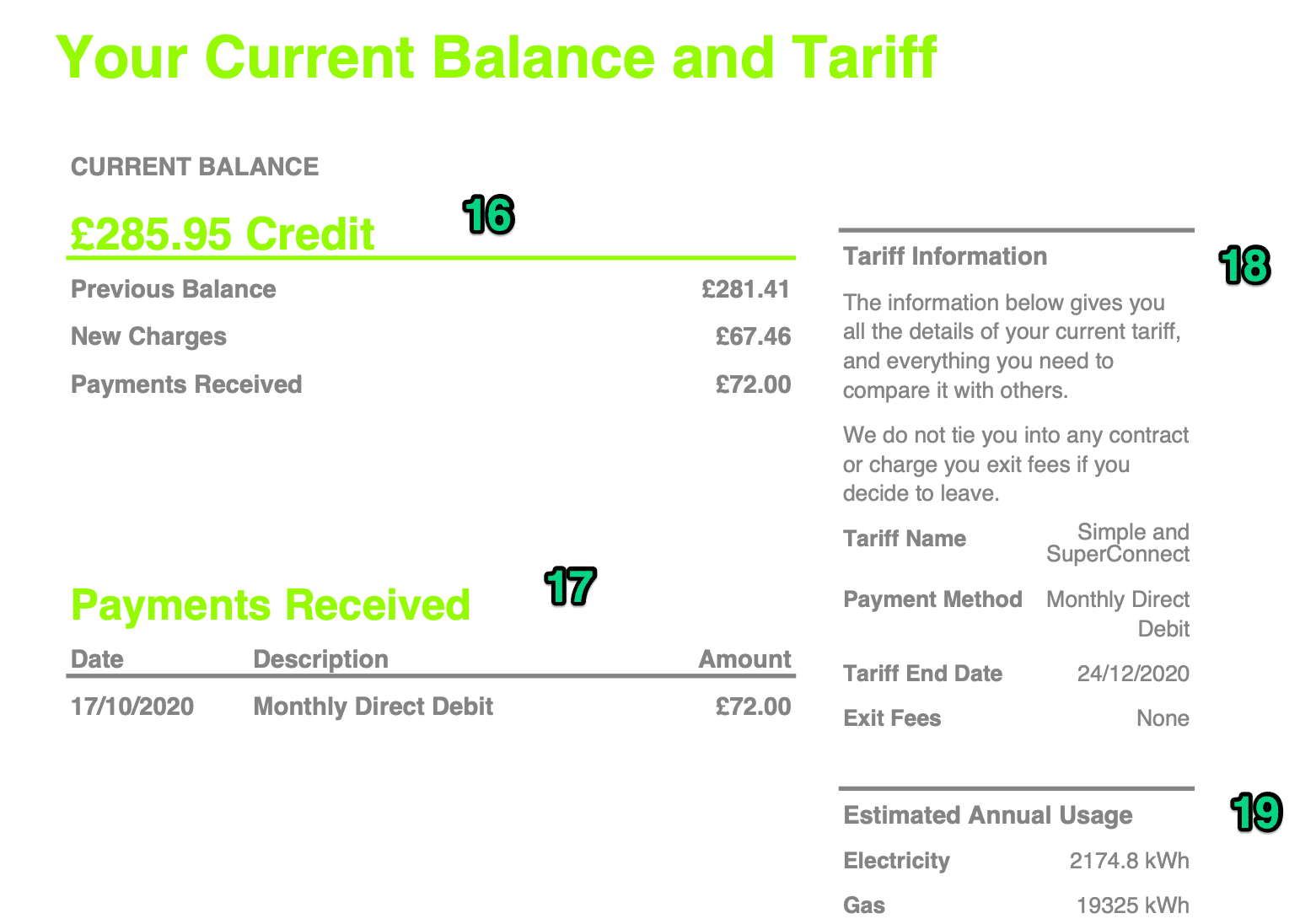
The details on this page show what transactions have taken place on the account as well as confirming tariff information:
- Current balance - This shows the customer's account is in credit, but it also includes a breakdown of the balance when the previous statement was issued, the new charges (which matches the combined electricity and gas charges on the previous charges) and any payments received.
- Payments received - This section gives more detail about the payments the customer has made including the date and payment type as well as the amount.
- Tariff information - This gives full details of the tariff the customer is on including their agreed payment method (monthly direct debit in this case), the tariff end date and whether there are exit fees associated with the tariff.
- Estimated annual usage - This gives an estimate of the number of kWh the supplier expects the customer to use over the course of a year. This is split down by fuel type.
Much of the information on this page can also be found elsewhere on the bill, but it's a good summary of the charges made and details of the tariff.
In this case, the customer is in credit. As the statement period is in autumn, leaving the credit balance on the account to cover extra costs over winter is a sensible idea. However, if you're heading into the summer months and there's a credit balance on your energy account, it might be worth reclaiming that credit.
The estimated annual usage detailed here can be used to help customer accurately compare energy quotes. Learn more about switching energy suppliers.
As we've mentioned, the final page of this bill (page five) details the terms and conditions associated with the energy supply.
Energy bills from different suppliers
Energy bills from individual energy suppliers may be laid out differently to the Avro Energy one we've used for illustrative purposes.
However, all the information will be on there and referring to the bill we've broken down page by page above can help you understand the different elements of your own bill.
Conclusion: understand your energy bills
Delving into the detail of your energy bill can help you figure out if you're on the wrong energy tariff or you're paying too much for your energy.
It can also alert you to specific problems such a back-bill for a large amount of energy you previously haven't been charged for - find out more about the rules on energy catch-up bills and customers' rights around them.
Customers signed up to online energy plans may have to take an extra step to access their energy bill - sometimes it might involve logging into the supplier's online portal and accessing the bill in that way.
It's definitely worth it, though, since working out we're coming to the end of a fixed energy plan in advance means we can move onto a good tariff straight away rather than being rolled onto a potentially expensive variable tariff.
If you think there's a problem with your energy bill or something doesn't make sense, read more about your rights as an energy customer and how to complain about an energy supplier.







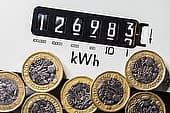

Comments (2)